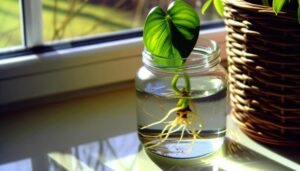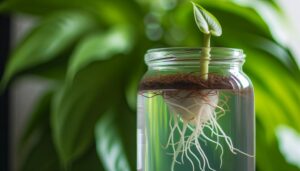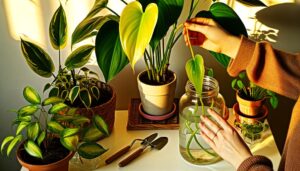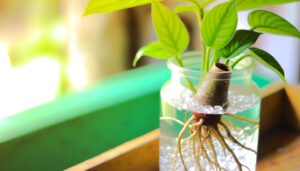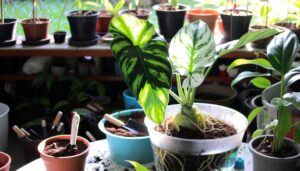Fiddle Leaf Philodendron Propagation: Easy Methods!
Propagating a Fiddle Leaf Philodendron is best performed during its active growth phase, from late spring to early summer. Ensure temperatures are between 70°F and 85°F, with humidity levels between 50% and 70%.
Utilize sharp, sterilized pruning shears to make a slanted cut below a node on a healthy, disease-free stem. Employ rooting hormones such as IBA or NAA to promote root development.
Prepare a potting mix with perlite, peat moss, and potting soil for prime drainage. Maintain proper environmental conditions and monitor for issues like root rot and pests.
Learn more to achieve peak propagation results.

Key Takeaways
- Propagate during late spring to early summer with temperatures between 70°F and 85°F.
- Use sharp, sterilized pruning shears to take robust stem cuttings below a node.
- Apply rooting hormones like IBA or NAA to enhance root development.
- Root cuttings in transparent containers with distilled water or in soil with perlite, peat moss, and potting soil.
- Maintain conditions with indirect light, 60-70% humidity, and temperatures at 70-75°F.
Choosing the Right Time
Choosing the best time for Fiddle Leaf Philodendron propagation is vital for ensuring successful root development and plant growth.
Ideal propagation typically occurs during the plant’s active growing season, which spans from late spring to early summer. During this period, the plant’s metabolic processes are accelerated, increasing the likelihood of successful rooting.
Ambient temperatures should consistently range between 70°F and 85°F (21°C to 29°C), as lower temperatures can impede cellular activities essential for root formation. Additionally, humidity levels should be maintained between 50% and 70% to support transpiration and reduce water stress.
Avoid propagating during dormancy in winter months, as reduced photosynthetic activity and slower metabolic rates can hinder root initiation and growth. Proper timing guarantees robust and resilient new plants.
Gathering Necessary Tools
For efficient propagation of Fiddle Leaf Philodendron, selecting appropriate pruning shears is important to guarantee clean cuts and minimize plant tissue damage.
Moreover, the application of a high-quality rooting hormone can greatly enhance root initiation and development.
To conclude, the preparation of a well-draining potting mix rich in organic matter is vital for providing ideal growing conditions.
Pruning Shears Selection
Choosing the right pruning shears is essential for ensuring clean cuts and promoting healthy growth in fiddle leaf philodendron propagation. Pruning shears should be sharp, sterilizable, and ergonomically designed to minimize plant tissue damage and reduce user fatigue.
When selecting pruning shears, consider the following:
- Blade Material: Opt for high-carbon steel blades for durability and precise cutting. Stainless steel is also acceptable for its corrosion resistance.
- Blade Type: Bypass blades are preferable, as they provide a cleaner cut compared to anvil blades, which can crush plant stems.
- Handle Design: Ergonomic handles with non-slip grips enhance control and comfort, reducing the risk of repetitive strain injuries.
Rooting Hormone Choice
Choosing a suitable rooting hormone is crucial for improving root development and increasing the success rate of fiddle leaf philodendron propagation.
Rooting hormones, mainly auxins like Indole-3-butyric acid (IBA) and Naphthaleneacetic acid (NAA), are available in different formulations. These come in powder, liquid, and gel forms, each providing unique benefits for particular propagation environments.
| Formulation | Application Method | Advantages |
|---|---|---|
| Powder | Dip cuttings | Convenient to store, cost-effective |
| Liquid | Dilute in water | Accurate concentration |
| Gel | Direct application | Improved adherence |
When choosing a rooting hormone, take into account factors such as ease of use, storage durability, and the specific requirements of the philodendron cuttings. Proper utilization guarantees the best absorption and successful root establishment.
Potting Mix Preparation
To prepare an ideal potting mix for fiddle leaf philodendron propagation, consistently gather essential tools such as a well-draining substrate, sterilized containers, and necessary adjustments like perlite and peat moss. These components guarantee optimal aeration, moisture retention, and root health.
Utilize the following steps to enhance the propagation success rate:
- Substrate Selection: Choose a mix combining equal parts of perlite, peat moss, and high-quality potting soil to promote drainage and retain necessary moisture.
- Container Sterilization: Employ sterilized containers to prevent pathogen transmission, enhancing plant health.
- Adjustment Integration: Incorporate perlite and peat moss to improve soil structure, guaranteeing adequate aeration and water retention.
These measures collectively foster a conducive environment for root development, crucial for successful propagation.
Selecting a Healthy Stem
Identifying a healthy stem for propagation necessitates examining the plant for stems that exhibit robust growth, free from disease or pests, and have several nodes.
The selected stem should be a vibrant green, indicating peak chlorophyll activity. Inspect for signs of fungal infections, such as black spots or mold, as well as any insect infestations like aphids or scale insects.
A stem with multiple nodes is preferable, as these nodes are potential sites for root development. Ensure the stem is firm to the touch and not exhibiting any signs of wilting or yellowing.
Making the Perfect Cut
Executing the perfect trim involves using a sanitized, sharp blade or pruning shears to make a neat, slanted cut just below a node. This technique enhances the cutting’s ability to absorb water and nutrients, promoting successful root development.
To achieve best results, follow these precise steps:
- Sanitize Equipment: Use 70% isopropyl alcohol to sanitize the cutting tools, effectively minimizing the risk of pathogen transmission.
- Locate the Node: Find a node on the healthy stem, as this is the site of meristematic activity essential for root initiation.
- Perform the Cut: Make a quick, slanted incision approximately 1 inch below the node, ensuring the cut surface area is optimized for water uptake.
Following these practices increases the likelihood of successful Fiddle Leaf Philodendron propagation.
Prepping the Cutting
After executing the precise cut, the next critical step involves preparing the cutting to optimize conditions for root formation and growth.
Begin by ensuring the cutting possesses at least one node, as this is where root development initiates. Remove any lower leaves close to the node to prevent rot and reduce transpiration.
Dip the cut end in a rooting hormone powder containing indole-3-butyric acid (IBA) to facilitate root genesis. Allow the treated cutting to air dry for approximately 30 minutes, forming a callus over the cut surface. This callusing process mitigates pathogen entry and desiccation.
Maintain the cutting in a humid environment, ensuring adequate but indirect light exposure, which promotes cellular differentiation and root proliferation.
Rooting in Water
To initiate the rooting process for Fiddle Leaf Philodendron cuttings, it is essential to select cuttings that exhibit strong, disease-free leaves and stems. Utilize a clear container, preferably glass, to monitor root development and guarantee the water is free from contaminants.
Root initiation typically begins within 2 to 4 weeks, though the timeline may vary based on environmental conditions and cutting health.
Selecting Healthy Cuttings
Selecting a healthy cutting for rooting in water involves identifying a segment of the fiddle leaf philodendron with at least two to three nodes and a few mature leaves. The cutting should exhibit robust growth without signs of disease or pest infestation.
Prior to cutting, make sure the tools used are sterilized to prevent contamination. Follow these steps:
- Identify and Cut: Choose a stem section with two to three nodes, ensuring it has vibrant, pest-free leaves.
- Sterilization: Sterilize pruning shears with isopropyl alcohol to reduce pathogen transfer.
- Trimming: Remove excess leaves, leaving only one to two at the top to decrease transpiration stress.
These steps are essential for the successful propagation of fiddle leaf philodendron in water.
Water Container Choice
Selecting an appropriate water container is essential for the successful rooting of fiddle leaf philodendron cuttings, as it guarantees ideal hydration and oxygenation for developing roots. Opt for transparent glass or plastic containers, which facilitate monitoring root growth and water clarity.
The container should be narrow enough to hold the cutting upright yet spacious enough to prevent crowding, allowing optimal water circulation. Ensure the container is sanitized to mitigate bacterial growth, using a diluted bleach solution (1 part bleach to 9 parts water) followed by thorough rinsing.
Fill the container with distilled or dechlorinated water, maintaining a depth that submerges the nodes but avoids leaf immersion, thereby preventing rot. Regularly replace the water to sustain nutrient and oxygen levels.
Root Development Timeline
For propagating fiddle leaf philodendron cuttings in water, the growth timeline typically spans four to six weeks, during which roots gradually emerge and elongate from the nodes. This period is crucial for successful propagation and demands careful monitoring.
- Week 1-2: Initial root primordia form, appearing as small pale nodules at the cutting’s nodes. Maintain a steady water level to guarantee nodes remain submerged.
- Week 3-4: Roots lengthen, becoming more prominent and fibrous. At this stage, it is crucial to change the water weekly to prevent microbial growth.
- Week 5-6: Root systems mature, showing sturdy branching. It is vital to transfer the cutting to soil when roots are approximately 2-3 inches long to aid in acclimatization.
Following these stages ensures optimal root development and plant well-being.
Rooting in Soil
To successfully propagate a Fiddle Leaf Philodendron through rooting in soil, begin by selecting a healthy stem cutting with at least one node and a few leaves. Utilize sterilized pruning shears to make a clean cut below the node.
Prepare a potting medium consisting of equal parts peat moss, perlite, and vermiculite to guarantee adequate aeration and moisture retention. Insert the cutting into the medium, making sure that the node is buried, while leaves remain above the surface. Gently firm the soil around the cutting to eliminate air pockets.
Water the soil thoroughly to moisten it, but make sure it is not waterlogged. Position the pot in indirect light to prevent desiccation of the cutting while promoting root initiation.
Creating Ideal Conditions
Ensuring ideal conditions for the propagation of a Fiddle Leaf Philodendron involves maintaining a consistent temperature range of 70-75°F, providing high humidity levels around 60-70%, and supplying bright, indirect light. These environmental parameters are essential for peak root development and plant health.
To achieve these conditions, consider the following:
- Temperature Control: Utilize a digital thermostat to precisely regulate the temperature.
- Humidity Maintenance: Employ a humidifier or humidity tray to maintain ambient moisture levels within the desired range.
- Lighting: Position the plant near a north-facing window or use grow lights to provide ample indirect illumination.
These steps create a microenvironment conducive to successful propagation, ensuring the cuttings receive the best conditions necessary for vigorous growth.
Transplanting the Cutting
After the Fiddle Leaf Philodendron cuttings have developed sufficient root systems, they are ready to be transplanted into individual pots filled with a well-draining, nutrient-rich potting mix. The transplantation process should be undertaken with caution to avoid damage to the delicate root structures.
- Select a pot with adequate drainage holes.
- Fill the pot with a suitable potting mix.
- Make a small hole in the center for the cutting.
- Place the cutting gently into the hole and firm the soil around it.
| Step | Description |
|---|---|
| 1 | Choose pot with drainage |
| 2 | Fill pot with potting mix |
| 3 | Create central hole |
| 4 | Insert cutting, firm soil |
Watering and Fertilizing
Proper hydration and nutrient supplementation are crucial for the healthy growth and development of newly transplanted Fiddle Leaf Philodendron cuttings.
- Watering Schedule: Keep soil moisture consistently at an excellent level. Water the cuttings when the top inch of the substrate feels dry to the touch, avoiding waterlogging to prevent root rot.
- Fertilization Protocol: Apply a balanced, water-soluble fertilizer diluted to half-strength biweekly. Essential macronutrients (NPK) and micronutrients like Calcium and Magnesium support robust growth.
- pH Balance: Monitor the soil pH, maintaining it within the ideal range of 5.5 to 7.0. Acidic or alkaline deviations can hinder nutrient uptake, stunting development.
Implementing these practices will create a favorable environment for vigorous root establishment and foliage proliferation.
Monitoring Growth
To maximize growth of Fiddle Leaf Philodendron cuttings, monitoring involves precise attention to ideal light conditions, accurate watering frequency, and specific nutrient requirements.
Implementing a regimen that includes sufficient indirect sunlight, maintaining consistent soil moisture, and administering balanced, slow-release fertilizers will promote robust development.
Regularly evaluating these parameters is crucial for achieving healthy propagation outcomes.
Optimal Light Conditions
Guaranteeing ideal light conditions is crucial for the successful propagation of Fiddle Leaf Philodendrons, as light intensity and duration directly impact photosynthesis and overall plant health.
Best light conditions encompass the following key elements:
- Light Intensity: Provide bright, indirect light. Utilize a light meter to ensure levels between 1,000 and 2,000 foot-candles.
- Duration: Maintain a consistent photoperiod of 12-14 hours per day using supplemental grow lights if natural light is inadequate.
- Avoid Direct Sunlight: Direct sunlight can cause photodamage, leading to leaf scorch. Position plants near north or east-facing windows.
Monitor growth by observing leaf color and internodal spacing; pale leaves and elongated stems indicate insufficient light. Adjust light sources accordingly to maintain prime growth conditions.
Watering Frequency Tips
Maintaining a suitable watering schedule is crucial for the ideal development and propagation of Fiddle Leaf Philodendrons, requiring close monitoring of soil moisture levels and plant health indicators.
Utilize a soil moisture meter to confirm that the substrate remains moderately damp but not waterlogged. Recommended watering frequency typically varies between once every 7-10 days, depending on ambient humidity and temperature conditions.
Visually examine the foliage for signs of water stress; yellowing or drooping leaves may indicate overwatering, while crisp edges suggest underwatering. Guarantee the pot has sufficient drainage to prevent root rot.
Adjustments should be made seasonally, as the plant’s water requirements can vary significantly between active growth periods and dormancy phases.
Nutrient Requirements
Adequate nutrient management is essential for the best growth and propagation of Fiddle Leaf Philodendrons, requiring a balanced fertilization regimen and regular assessment of plant health. Monitoring and adjusting nutrient levels involves understanding the plant’s specific macro and micronutrient needs.
A thorough approach includes:
- Nitrogen (N): Necessary for vegetative growth, promoting strong leaf development. Apply a nitrogen-rich fertilizer during the growing season to improve foliage.
- Phosphorus (P): Facilitates root development and energy transfer. Use a balanced fertilizer with sufficient phosphorus to support root health and subsequent propagation.
- Potassium (K): Critical for overall plant vigor, aiding in disease resistance and water regulation. Make sure potassium levels are enough to maintain plant resilience and ideal growth conditions.
Regular soil testing and visual plant inspections are essential for maintaining nutrient balance.
Troubleshooting Common Issues
When propagating Fiddle Leaf Philodendrons, one may encounter issues such as root rot, pest infestations, and inadequate humidity levels, which require prompt and precise interventions.
Root rot, caused by overwatering or poor drainage, necessitates immediate re-potting in well-draining soil and pruning of affected roots.
Pest infestations, commonly from spider mites or aphids, demand the application of insecticidal soap or neem oil.
Inadequate humidity, detrimental to root development, can be mitigated by maintaining a consistent humidity level of 60-70% using a humidifier or a humidity tray.
Monitoring environmental conditions and providing appropriate care are paramount to ensuring successful propagation and robust growth of Fiddle Leaf Philodendrons.
Conclusion
Propagation of the fiddle leaf philodendron necessitates meticulous timing, tool selection, and technique. Selecting a sturdy stem and making strategic cuts promotes ideal growth.
Proper preparation and transplantation, coupled with precise watering and fertilizing, foster healthy development. Monitoring progress and addressing prevalent problems prevent propagation pitfalls.
This scientific strategy for successful stem propagation underscores the importance of precision, patience, and proactive practices.

